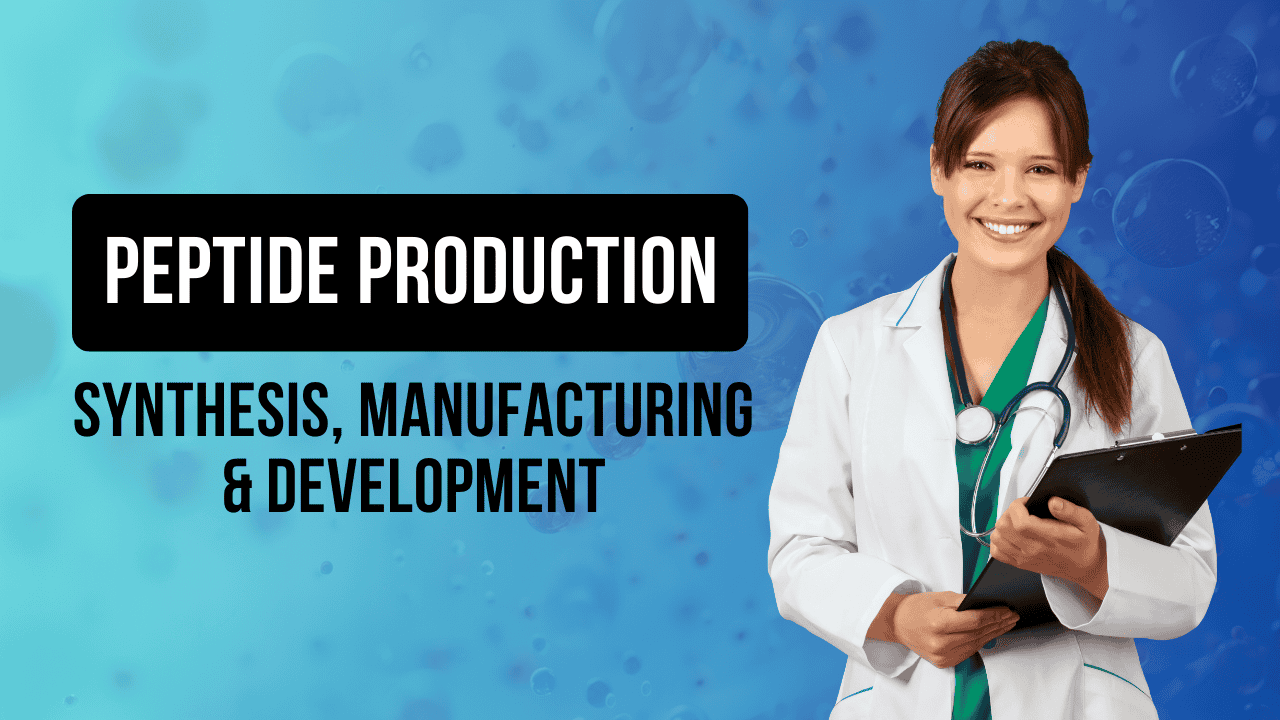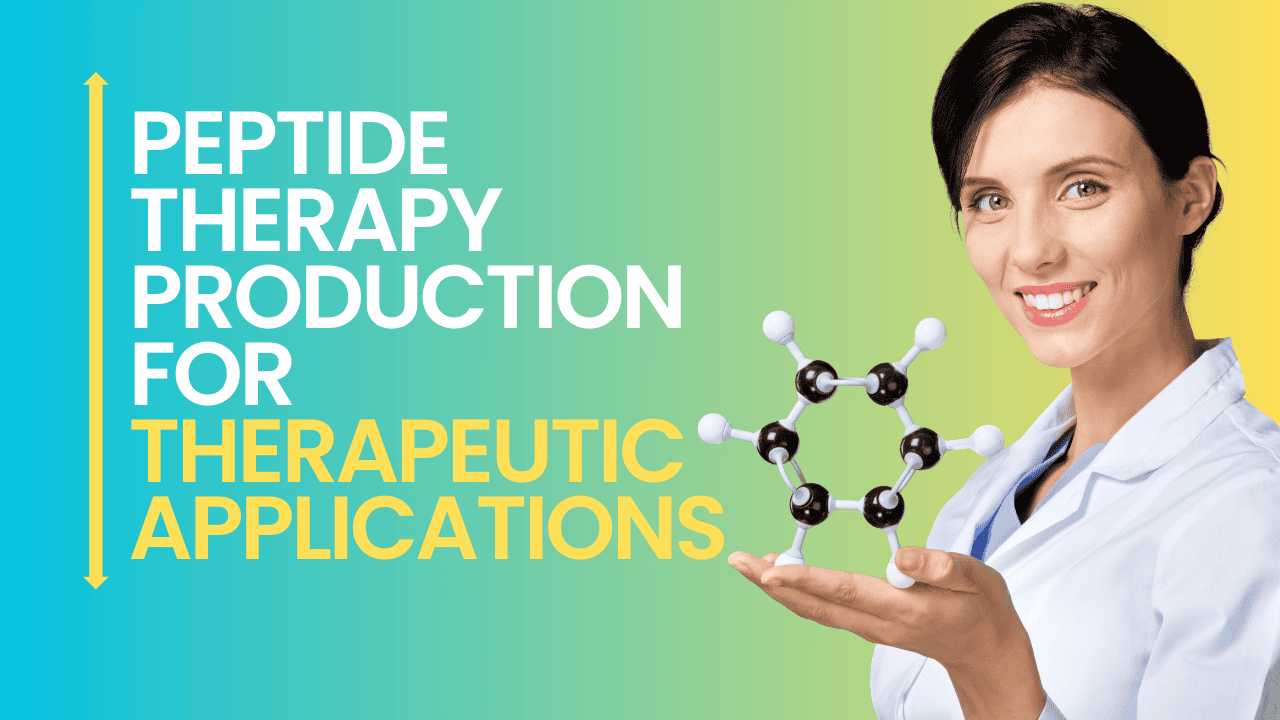

Exploring the cutting-edge techniques in peptide and protein synthesis, this article delves into the nitty-gritty of solid-phase peptide synthesis, synthetic peptide methods, and innovations in protein synthesis.
Get ready to uncover the nuances of peptide science and how it transforms life science research.
Peptide synthesis and protein synthesis are fundamental to understanding life science research. Imagine you’re building a LEGO structure; each peptide is a single block, while proteins are the epic castles you create from those blocks. But, unlike LEGO, the synthesis of peptide and protein is far more intricate and essential for biological functions.
Synthetic peptide plays a crucial role in research as it allows scientists to study specific sequences and interactions within a controlled environment. Picture solving a crime mystery—each peptide is a clue, and synthetic peptides help us piece together the broader picture of biochemical processes.
While peptide synthesis involves bonding amino acids to form short chains, protein synthesis is akin to crafting a full novel from individual sentences. The complexity and length of the protein molecules require more advanced techniques and understanding.
Solid-phase peptide synthesis (SPPS) is a method where peptides are synthesized while anchored to a solid support. Think of threading beads onto a string to create a necklace—each bead represents an amino acid bonded through peptide synthesis.
SPPS operates by sequentially adding amino acids, protected by groups like Fmoc or Boc, to the growing peptide chain. Envision a chef meticulously adding one ingredient at a time to a gourmet dish, ensuring each piece finds its perfect place in the recipe.
Solid-phase synthesis is preferred due to its efficiency and ease of purifying the peptide product. It’s like comparing handwritten letters to emails—solid-phase synthesis drastically reduces time and error, making it the go-to method for creating complex peptides.
Approaches such as Fmoc solid-phase peptide synthesis and Boc-based methods are at the forefront. Each technique has its ace up the sleeve, much like choosing between classical piano and electric guitar—the best method depends on the context and desired peptide.
HPLC is indispensable for peptide purification, removing impurities to isolate the desired peptide product. Imagine sifting through a chaotic jumble of notes to create a symphony—HPLC ensures every part of the peptide sequence hits the right tune.
Protecting groups like Fmoc and Boc safeguard amino acids from side reactions during synthesis. It’s like equipping soldiers with armor and shields to fend off distractions and ensure they march straight to form the peptide chain.
Innovations such as microwave-assisted peptide synthesis have turbocharged yields. Think of upgrading from a horse-drawn carriage to a Tesla—increased speed, efficiency, and reliability are the hallmarks of modern solid-phase synthesis.
Advanced resins and linkers improve the attachment and detachment of the growing peptide from the solid support. It’s akin to getting better Velcro—you get a stronger hold when needed and an easier peel-off when the synthesis is complete.
Automation in solid-phase synthesis minimizes human error and increases throughput. Picture robots on an assembly line constructing precision-engineered cars; automation ensures that the growing peptide sequence is built with impeccable accuracy.
Protein synthesis is fraught with obstacles like proper peptide folding and managing longer peptide chains. It’s like trying to fold a king-sized sheet solo—a daunting task requiring skill, patience, and sometimes a helping hand.
Cell-free protein synthesis allows researchers to produce proteins outside of living cells, offering greater control and speed. It’s much like using a simplified model to test architectural principles before constructing a full-scale building.
Emerging trends include total chemical synthesis of proteins and improved methods for the synthesis of difficult sequences. These advancements are akin to getting supercharged tools for DIY projects—the process becomes more accessible and effective.
Microwave-assisted peptide synthesis utilizes microwave energy to accelerate reactions. Imagine making popcorn in a microwave versus an old stovetop—quicker, more efficient, and with fewer chances of burning.
By heating reactions more uniformly and quickly, microwave-assisted synthesis reduces the overall synthesis time. This efficiency boost is similar to switching from a regular light bulb to an LED—brighter performance with less energy consumption.
Safety is paramount when employing microwave technology. Precautions include using specialized equipment and monitoring reactions closely, much like wearing protective gear and keeping a vigilant eye when using heavy machinery.
The choice of method depends on factors like peptide length, sequence complexity, and desired yield. It’s like deciding between walking, biking, or taking an Uber—the journey’s requirements dictate the best mode of travel.
Peptide purification often uses techniques like HPLC to isolate pure synthetic peptides. Think of it as a gold panning process, sifting through riverbed sediment to find the valuable nuggets—pure synthetic peptide is the treasure we seek.
Methods like Fmoc and Boc each have their pros and cons. Fmoc solid phase peptide synthesis offers easier removal, while Boc methods may provide greater stability. It’s akin to choosing between a sleek sports car and a rugged SUV—each has its strengths depending on the terrain.
Innovations include the development of more efficient catalysts and more robust resins. These advancements are transforming the field much like smartphones revolutionized communication—making complex tasks simpler and more accessible.
New solvent systems improve the efficiency and safety of peptide synthesis processes. It’s similar to finding eco-friendly fuel options that power cars more cleanly and effectively, giving the peptide synthesis field an environmental and performance boost.
Computational methods assist in predicting peptide structures and optimizing synthesis routes. Imagine having a GPS for your synthesis journey, guiding you through the most efficient and safest paths to reach your synthetic peptide destination.
Peptide synthesis is often simpler than protein synthesis due to the shorter chain lengths and fewer required steps. Imagine assembling a jigsaw puzzle with fewer pieces—peptide synthesis is more straightforward, whereas protein synthesis, like a 1000-piece puzzle, demands more effort and precision.
Costs vary based on method complexity, reagent prices, and equipment needed. Fmoc solid-phase peptide synthesis might be costlier upfront but offers quicker turnaround, similar to how investing in a quality tool set pays off with long-term savings and efficiency.
Pitfalls include side reactions, incomplete reactions, and purification challenges. These issues can be akin to speed bumps and potholes on a road trip—unexpected obstacles that can slow progress unless well-navigated.
Peptides and proteins play pivotal roles in developing new drugs, offering targeted therapies and novel treatments. Imagine peptides as specialized keys designed to unlock specific biological doors, opening paths to innovative medical solutions.
Peptides are crucial in formulating vaccines that elicit specific immune responses. Think of them as training targets for the immune system, helping it learn and recognize the threats it needs to combat.
In cancer research, synthetic peptides are employed to study tumor markers and develop targeted treatments. They are like secret agents, designed to infiltrate cancer cells and disable their defenses from within.
Common problems include formation of side reactions and difficulties in purification. Solutions might involve using protective groups like Boc or optimizing reaction conditions, akin to finding anti-virus software to eliminate unwanted bugs from your system.
Optimization involves fine-tuning conditions such as temperature, pH, and reagent concentrations. Imagine being a barista perfecting your coffee recipe—tweaking variables until you achieve the ideal blend.
Quality control includes HPLC analysis and mass spectrometry to ensure peptide purity and identity. It’s comparable to quality checks in manufacturing, where every product batch is scrutinized to meet exacting standards.
The future promises advanced automation, enhanced computational methods, and green chemistry approaches. It’s like looking ahead to a sci-fi world where technology makes seemingly impossible feats routine.
Biotechnology advancements are expected to revolutionize protein synthesis, making processes more efficient and accessible. Picture upgrading from rudimentary tools to sophisticated gadgets—a leap that transforms capabilities and outcomes.
Emerging technologies include CRISPR, novel catalysts, and integrated computational tools. These advancements promise to reshape the landscape of what’s achievable, akin to moving from the age of steam engines to the space age.
Green chemistry principles focus on reducing waste and using non-toxic materials. It’s similar to eco-friendly practices like recycling and renewable energy in everyday life—integrating sustainability into every step of the synthesis process.
Environmental impacts include resource consumption and waste production. Researchers strive to minimize these effects, much like eco-conscious consumers who prioritize sustainable practices in their daily lives.
Sustainability can be enhanced through the use of biodegradable reagents and energy-efficient techniques. Think of it as swapping disposable items for reusable alternatives—small changes that make a significant impact.
Amino acids link together through peptide bonds to form peptides and proteins, much like train cars connecting to form a whole train. The correct sequence ensures the train reaches its destination: functional biological molecules.
The genetic code dictates the sequence of amino acids during protein synthesis. It’s similar to following a recipe card—each codon in the genetic code corresponds to a specific ingredient (amino acid) needed for the dish (protein).
Protein folding involves the arrangement of peptide bonds into a functional three-dimensional structure. Imagine assembling a papercraft model where every fold (peptide bond) ensures the final shape is correct and functional.
Historic milestones include the discovery of the ribosome’s role in protein synthesis and the development of peptide synthesis methods. It’s akin to humanity’s leap from the wheel to the car—each breakthrough builds on previous discoveries.
Solid-phase peptide synthesis has advanced from manual techniques to automated systems, drastically increasing efficiency and reliability. It’s similar to evolving from handwritten letters to instant messaging—each step represents a significant technological leap.
Notable pioneers include Bruce Merrifield, who developed SPPS, revolutionizing peptide synthesis. These pioneers are like the trailblazers of science, whose innovations opened new avenues for exploration and understanding.
Essential safety practices include using appropriate protective equipment, handling reagents carefully, and following protocols rigorously. It’s akin to using safety gear in extreme sports—essential for preventing accidents and ensuring successful outcomes.
Laboratory safety involves proper ventilation, use of personal protective equipment (PPE), and careful handling of chemicals. Imagine operating in a kitchen with sharp knives and hot stoves—keeping safety in mind is crucial to avoid accidents.
Potential hazards include thermal burns and chemical spills. Proper training and equipment use mitigate these risks, much like learning to drive requires understanding the road rules and vehicle operation for safety.
To synthesize a peptide, you typically use solid-phase peptide synthesis (SPPS). This involves sequentially adding amino acids to a growing peptide chain anchored to a resin. Protecting groups like Fmoc are used to prevent side reactions. Peptide fragments are then coupled and purified to obtain the desired peptide.
Basic peptide synthesis involves sequentially linking amino acids via peptide bonds. Solid-phase synthesis and liquid-phase peptide synthesis are common methods. Fmoc and Boc groups protect amino acid functionalities during the process. This peptide chemistry forms the backbone of most synthetic peptides.
Yes, you can make your own peptides using peptide synthesizers. These automated machines handle the complex process of peptide bond formation and peptide coupling. They use strategies in solid-phase organic synthesis. However, home synthesis of peptides can be challenging without proper equipment and expertise.
Synthetic peptides are generally safe when produced and administered correctly. The American Chemical Society provides guidelines for safe handling. However, improper synthesis or contamination can pose risks.
Synthetic peptides are made of amino acids linked by peptide bonds. They can be customized using various protecting groups and synthesis methods. This allows for the creation of specific peptides that mimic native peptide sequences.
Peptides are not universally FDA approved mainly due to the difficulty in ensuring purity and consistency in complex peptide synthesis. However, peptide therapeutics are emerging, with some drugs passing stringent FDA approval processes.
Yes, several peptides are considered safe and are used in medical treatments. For instance, certain synthetic peptides are used in peptide drugs for chronic conditions. Always consult a healthcare provider for safety information.
Potential downsides include allergic reactions and side effects from impurities in the crude peptide. Proper peptide characterization and consultation with healthcare professionals can mitigate these risks.
Standard peptide synthesis usually involves solid-phase methods where the peptide is anchored to a resin. Fmoc or Boc protecting groups are used, and the peptide is cleaved from the resin once the synthesis is complete.
Peptides are short chains of amino acids connected by peptide bonds. They are synthesized through methods like solid-phase peptide synthesis. Peptides are crucial in biological processes and have applications in drug development and research.
Dr. Stephen Kent is a preeminent figure in the field of peptide synthesis, known for pioneering the concept of native chemical ligation. With over 30 years of experience, Dr. Kent has significantly impacted the synthesis of proteins and understanding of their structure-function relationships. His groundbreaking research has enabled the total synthesis of complex proteins, allowing for advances in drug development and biochemistry.
Dr. Kent’s notable publications include:
Dr. Kent’s work is characterized by his innovative methodologies and scientific rigor, earning him numerous accolades, including the American Chemical Society’s Ralph F. Hirschmann Award in Peptide Chemistry. His contributions underscore his authority and trustworthiness in peptide synthesis.
Dr. Philip E. Dawson is a distinguished researcher in peptide chemistry, recognized for his contributions to the development of synthetic and bioconjugation techniques. He has extensive expertise in the synthesis of peptides and proteins using chemical ligation methods. With a background in both chemistry and biomedical sciences, Dr. Dawson’s work has bridged the gap between fundamental research and therapeutic applications.
Key publications by Dr. Dawson include:
Dr. Dawson’s dedication to advancing peptide synthesis techniques has earned him the American Peptide Society’s Rao Makineni Lectureship and solidified his reputation as a leading expert. His work is known for its precision and impact in the field, making him a trusted and authoritative voice in peptide science.
Becker, C. F., Brik, A., Dawson, P., & Hackenberger, C. P. R. (2014). Chemical protein synthesis. Journal of Peptide Science, 20(2), 63. https://doi.org/10.1002/psc.2607
Gatzemeier, L. M., Meyer, F., Diederichsen, U., & Outeiro, T. F. (2023). Chemical synthesis of Alpha‐Synuclein proteins via Solid‐Phase peptide synthesis and native chemical ligation. Chemistry – a European Journal, 29(33). https://doi.org/10.1002/chem.202300649
Jakubowski, H. (2016). Aminoacyl‐tRNA synthetases and the evolution of coded peptide synthesis: the Thioester World. FEBS Letters, 590(4), 469–481. https://doi.org/10.1002/1873-3468.12085
Kleinkauf, H., & Von Döhren, H. (1987). Biosynthesis of peptide antibiotics. Annual Review of Microbiology, 41(1), 259–289. https://doi.org/10.1146/annurev.mi.41.100187.001355
Larsen, B. D., & Holm, A. (1998). Sequence‐assisted peptide synthesis (SAPS). Journal of Peptide Research, 52(6), 470–476. https://doi.org/10.1111/j.1399-3011.1998.tb01251.x
Liu, T., Peng, Z., Lai, M., Hu, L., & Zhao, J. (2024). Inverse peptide synthesis using transient protected amino acids. Journal of the American Chemical Society, 146(6), 4270–4280. https://doi.org/10.1021/jacs.4c00314
Polikanov, Y. S., Etheve-Quelquejeu, M., & Micura, R. (2023). Synthesis of Peptidyl-tRNA mimics for structural biology applications. Accounts of Chemical Research, 56(19), 2713–2725. https://doi.org/10.1021/acs.accounts.3c00412
Zhou, Y., Li, H., Huang, Y., Li, J., Deng, G., Chen, G., Xi, Z., & Zhou, C. (2023). Suppression of alpha-carbon racemization in peptide synthesis based on a thiol-labile amino protecting group. Nature Communications, 14(1). https://doi.org/10.1038/s41467-023-41115-x
ALL ARTICLES AND PRODUCT INFORMATION PROVIDED ON THIS WEBSITE ARE FOR INFORMATIONAL AND EDUCATIONAL PURPOSES ONLY. The products offered on this website are intended solely for research and laboratory use. These products are not intended for human or animal consumption. They are not medicines or drugs and have not been evaluated or approved by the FDA to diagnose, treat, cure, or prevent any disease or medical condition. Any form of bodily introduction is strictly prohibited by law.



Discount Applied Successfully!
Your savings have been added to the cart.